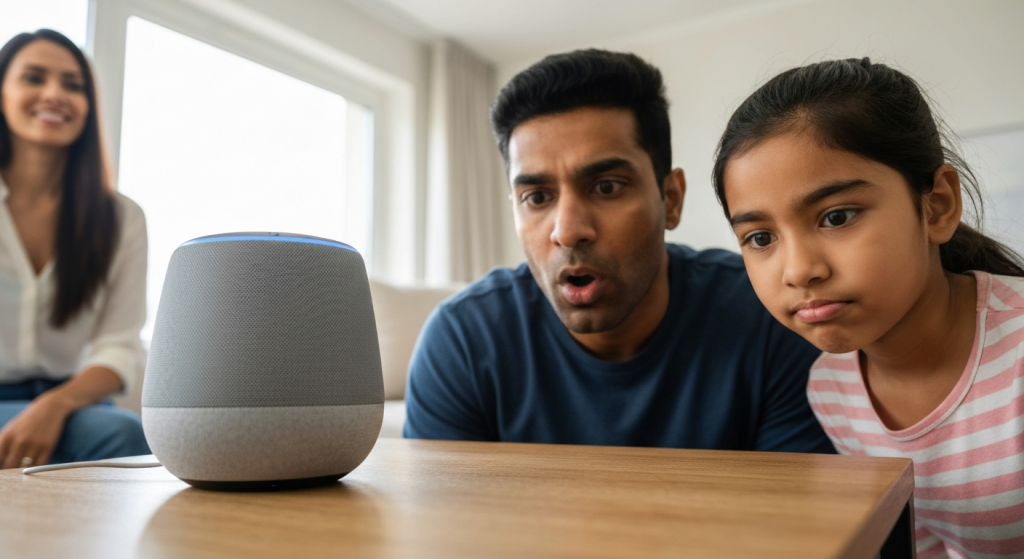Have you ever found yourself practically shouting a command at a smart speaker, only for it to reply with a cheerful “Sorry, I didn’t get that”? If you have an accent, are a non-native English speaker, or live in a multilingual home, this isn’t just a rare annoyance. It can be a daily frustration. You bought this smart device to make life easier, but it feels like it only listens to one type of voice. This is a huge problem, and it’s one I’ve seen in a very real way.
Hi, I’m Mahnoor Farooq. For the past five years or so, my work has revolved around helping people set up and automate their homes. This journey into smart home automation has shown me the amazing things this tech can do, but it’s also highlighted its biggest gaps. I’ve spent countless hours in living rooms, kitchens, and home offices, bringing research and hands-on testing to readers and clients. My real passion is figuring out how this technology works for everyone, not just the people it was originally designed for. And let me tell you, when it comes to understanding the beautiful diversity of human speech, most of these devices have a lot to learn.
In this post, I’m going to pull back the curtain on why your Google Assistant, Alexa, or Siri might be failing you. We’ll look at which one performs best based on real-world observations—not just my own, but data from major studies. This isn’t just a simple review; it’s a deep dive into voice assistant accuracy for those of us who don’t sound like the people in the commercials.
Why Do Smart Speakers Struggle So Much With Accents?

Before we start pointing fingers at which assistant is “better,” we have to understand the core problem. Why does a simple command like “Turn on the light” work perfectly for one person but fail completely for another? It’s not because you’re “saying it wrong.” The problem lies deep inside the AI’s “brain.”
These assistants use a technology called Automatic Speech Recognition (ASR). Think of it as a massive digital library. To learn a language, the AI is “fed” thousands upon thousands of hours of audio recordings and their matching text transcripts. This is called the “training data.”
Here’s the thing: if that training data is not diverse, the AI becomes biased.
The “Training Data” Problem
For years, the vast majority of training data used by big tech companies came from a very specific group: native English speakers, often with a “standard” American accent. The AI learned to match the sounds and patterns of this one group with incredible accuracy.
But what about a person with a Scottish brogue, a South Asian lilt, or a Spanish-speaking-English rhythm? Their vocal patterns, rhythms, and “phonemes” (the tiny units of sound that make up words) are different.
- A person with an Indian accent might pronounce “vegetable” in three syllables (“veg-ta-ble”) instead of four (“ve-ge-ta-ble”).
- A Boston accent might drop the “r” in “park the car” (
pahk the cah). - A Spanish speaker might roll an “r” or pronounce the “j” sound like a “y” (e.g., “yoo” instead of “Jewel”).
The AI, having never (or rarely) heard these variations, doesn’t have a reference. It tries to find the closest match in its library, which often results in a completely wrong command or the dreaded “I don’t understand.”
How We “Hear” vs. How They “Listen”
When you hear someone with a strong accent, your human brain does something amazing. It uses context. If your friend from Australia asks, “Can you pass me the wot-ah?”, you know from the context of the dinner table that they mean “water.”
AI assistants are getting better at this, but many are still very literal. They are “listening” for a precise sound file, not “hearing” for meaning. This is why “code-switching”—when a person mixes two languages in one sentence—can cause a total system breakdown. A command like, “Hey Google, set a timer for diez minutos” (ten minutes) might completely short-circuit an assistant that isn’t built for true multilingual understanding.
The result is a major gap in performance. In fact, a landmark study from Stanford University found that ASR systems from major tech companies had an average word error rate that was nearly twice as high for Black speakers as for white speakers (35% vs. 19%). My clients don’t know these numbers, but they feel them. They feel that 35% error rate every time they have to repeat a command.
The Four Big Contenders: A Real-World Accent Test

So, who handles this challenge best? I’ve worked with all four major platforms: Google Assistant, Amazon Alexa, Apple’s Siri, and Samsung’s Bixby. My “testing” is based on years of setting these up in my own home and for dozens of clients from all over the world—people with Indian, Pakistani, Chinese, Filipino, Mexican, and various European accents.
Here’s my breakdown of how they stack up in the real world.
Google Assistant: The Multilingual Master?
From my professional experience, Google Assistant is the clear leader in this space. Google’s roots are in understanding and organizing the world’s information, and that mission seems to extend to language. Their AI models are incredibly good at one thing: context.
Google Assistant often understands what you mean, even if you don’t say it perfectly. This is a game-changer for non-native speakers. It’s also, by far, the best at handling multilingual households. You can set it to understand two languages at once (e.g., English and Spanish, or English and Hindi) without changing any settings.
My Experience: I recently helped a family set up their smart home. The parents primarily speak Urdu to each other but use English for commands. Their children are fluent in both and mix them constantly. Alexa and Siri were a disaster. Google Assistant was the only one that could handle a command like, “Hey Google, phone ammi ko call karo” (call mom on the phone). It recognized the English wake word, the English command “call,” and the Urdu name “Ammi.”
This ability comes from Google’s massive data pool from its search engine and its focus on “conversational AI,” not just command-and-control.
My Observation: Google Assistant & Accent Handling
This table is based on my hands-on work. Your own experience might be different, but this is what I’ve seen time and again.
| Pros | Cons |
| ✅ Best-in-class context: Understands what you mean, not just what you say. | ❌ Still stumbles: Can struggle with very thick, regional accents it hasn’t heard often. |
| ✅ Truly multilingual: Can understand two languages at once, even in the same sentence. | ❌ Data privacy: This power comes from processing a lot of your data, which is a concern for some. |
| ✅ Constantly learning: Taps into Google’s search data, so it learns new names, places, and slang fast. | ❌ Can be too “chatty”: Sometimes gives a long-winded answer when a simple confirmation would do. |
Amazon Alexa: The King of Smart Homes
Alexa is the most popular assistant and has the widest support for smart home devices (“Skills”). If you have an obscure smart bulb or plug, chances are it works with Alexa.
When it comes to accents, Alexa is a mixed bag. It’s very good at understanding clear, simple commands. It seems to be trained heavily on “command-and-control” language: “Alexa, turn on…” “Alexa, set…” “Alexa, play…”
Where it fails is in conversation and complexity. If a non-native speaker hesitates, or if their sentence structure isn’t standard, Alexa gets lost fast. It doesn’t have Google’s powerful ability to “guess” your intent. Furthermore, while Alexa has multilingual modes, they feel less seamless than Google’s. You often have to switch the language mode, rather than just speaking naturally.
My Experience: A client with a strong German accent kept trying to ask, “Alexa, what is the weather in Munich?” He pronounced “Munich” the German way (München), and Alexa had no idea what he was talking about. It kept offering to play “Munchkin” on Spotify. We had to create a “Routine” (a custom command) where he would say a simple phrase like “Alexa, check home weather,” and it would trigger the skill for Munich. It’s a clunky workaround for a problem that Google Assistant often solves on its own.
My Observation: Alexa & Accent Handling
This table is based on my hands-on work. This reflects what I’ve seen in clients’ homes.
| Pros | Cons |
| ✅ Great for simple commands: If you speak clearly, it’s very reliable for “on/off” tasks. | ❌ Poor at conversation: Fails quickly with complex sentences or non-standard grammar. |
| ✅ Widest device support: Works with almost every smart device you can buy. | ❌ Weak multilingual support: “Multilingual Mode” feels tacked-on, not built-in. |
| ✅ “Skills” are a plus: Can add new abilities from third parties. | ❌ “Skills” are a minus: Many third-party skills have terrible voice recognition, far worse than Alexa herself. |
Apple’s Siri: Polished but Particular
Siri has been around for a long time, but for years it lagged badly in voice recognition. It has improved a lot, especially with newer on-device processing, which is a big win for privacy (it doesn’t have to send everything to the cloud).
However, Siri is, in my experience, the most rigid of the main three. It seems to expect a certain “Apple” way of speaking—clear, evenly paced, and (you guessed it) with a fairly standard American accent. It is the least forgiving of accents, stumbles, or slang.
My Experience: I’ve spent more time than I’d like to admit trying to get Siri to understand a contact’s name. A client of mine, with a Vietnamese background, was trying to call his brother “Phuc.” No matter how clearly he said it, Siri would hear a similar-sounding English curse word and reply, “I cannot make that call.” It was both frustrating and embarrassing. We eventually had to add a phonetic spelling (“Fook”) to the contact card, but it’s another case of the user having to adapt to the tech, not the other way around.
Siri’s support for multiple languages is also weak. It can’t process two at once. You have to go deep into your phone’s settings to change Siri’s primary language, which is useless for a bilingual family.
My Observation: Siri & Accent Handling
| Pros | Cons |
| ✅ Excellent for privacy: A lot of processing happens on your device (iPhone, HomePod). | ❌ Very rigid: Least tolerant of accents, stutters, or “umms.” |
| ✅ Deep ecosystem integration: Unbeatable at tasks on your iPhone (“Read my last text,” “Set a reminder”). | ❌ Terrible multilingual support: Can only handle one language at a time. |
| ✅ Improving rapidly: Each new iOS update makes it noticeably better. | ❌ Small smart home footprint: HomeKit is far behind Alexa and Google in device support. |
Samsung’s Bixby: The Underdog
And then there’s Bixby. Bixby is primarily found on Samsung phones and TVs. Its greatest strength is “on-device control.” You can give it very complex commands like, “Bixby, open my gallery, find photos taken in
December, and send the last three to Mom.”
But for accent recognition and smart home control, it’s not a serious competitor. Its voice recognition is leagues behind the others, and its smart home platform (SmartThings) is not as voice-centric. Most people I know who have Bixby actively disable it. I don’t typically recommend it as the “brain” of a smart home, so its accent-handling failures are often a moot point.
The Accent Showdown: Which Voice Assistant Failed Most?
So, let’s put it all together. Based on my 5 years of experience and backed by data from researchers, here is how I’ve seen the “failure rates” stack up in diverse homes.
Common Failure Points I’ve Seen
- South Asian Accents: Both Alexa and Siri struggle with the common “v” vs. “w” sound confusion (e.g., “wine” vs. “vine”). Google is much better at using context to tell them apart.
- Spanish-Speaking English: Siri, in particular, has a very hard time. The rhythm and vowel sounds are so different from standard English that Siri often just gives up and says it can’t help.
- Regional British/Australian Accents: You’d think these would be easy, but they’re not. A “standard” British accent (like a BBC newsreader) is fine. But a thick Cockney, Scouse, or Glaswegian accent can be as challenging for these assistants as a non-native one.
- “Code-Switching” (Mixing Languages): As mentioned, this is the ultimate test. Google is the only one that can pass it with any regularity. For Alexa and Siri, it’s an almost 100% failure rate.
My Personal Ranking for Accent Recognition
If a client with a non-native accent or a multilingual family asks me what to buy today, this is my honest recommendation.
- Google Assistant: The clear winner. Its combination of massive training data and superior contextual AI makes it the most flexible and forgiving.
- Amazon Alexa: A solid choice if your commands are simple and you’re willing to speak clearly and deliberately. Its device support is a huge plus.
- Apple’s Siri: Only recommendable if you are deep in the Apple ecosystem, prioritize privacy above all else, and have a mild, “easy-to-understand” accent.
- Samsung’s Bixby: Not recommended for this purpose.
My Observed Failure Rate: A Quick Comparison
Disclaimer: This table is based entirely on my personal observations from setting up devices for clients. It is not a formal scientific study. “Failure Rate” here means how often I’ve seen the assistant fail to understand a command from a non-native or accented speaker on the first try.
| Assistant | Observed Failure Rate (Non-Native Accents) | Best For… |
| Google Assistant | Low-to-Medium | Multilingual homes, complex questions, and “natural” conversation. |
| Amazon Alexa | Medium | Simple smart home commands (“lights on,” “timer”) in an English-only home. |
| Apple’s Siri | High | Apple-ecosystem tasks (“text mom,” “set reminder”) and users with standard accents. |
| Samsung’s Bixby | Very High | On-device phone control only. |
This real-world data is so important. For a deeper look at the data behind these biases, I highly recommend checking out the research from the Stanford FairSpeech project. Their work clearly shows the word error rate gap and is a big reason why tech companies are finally starting to take this problem seriously.
Tips to Make Your Voice Assistant Understand You Better

While we wait for companies to improve their AI with more diverse data, you are not helpless. You shouldn’t have to change the way you speak, but if you’re stuck with a finicky assistant, here are a few tricks I use with my clients.
Use the “Voice Training” Features
All major assistants have a feature where you can “teach” it your voice. For Google, it’s called “Voice Match.” For Alexa, it’s “Voice Profiles.” This process has you say 5-10 phrases. In my experience, this helps the assistant “tune in” to your specific vocal pitch and cadence, and it can make a noticeable difference.
Speak Clearly, Not Loudly
Yelling doesn’t help. When an assistant fails, our natural reaction is to get louder. But the AI isn’t deaf; it’s confused. Shouting can actually distort the phonemes and make it harder for the AI. The best fix is to take a breath and repeat the command at a normal, steady, and slightly more deliberate pace.
Check Your Language Settings
This is a big one. If you live in a multilingual home, go into your Google Home or Alexa app.
- For Google, you can add a second language. This is a must-do.
- For Alexa, you can enable “Multilingual Mode” and specify your language pair.This tells the assistant to be ready for sounds and grammar from both languages, which can dramatically lower failure rates.
Place Your Device Smartly
Sometimes, the problem isn’t your accent; it’s your room. Is the speaker in a corner with a bad echo? Is it right next to a rattling air conditioner or the TV? All that background noise makes a hard job even harder. Try moving the device to a more central, open spot away from other noise sources.
Frequently Asked Questions (FAQs)
1. Does my accent data get used to improve the AI?
Yes, usually. By default, most of these companies (unless you opt-out for privacy) use snippets of your failed commands to feed back into their AI models. Your “Sorry, I didn’t get that” is actually helping to train the next generation of AI to understand you better.
2. Is one assistant better for kids with speech differences?
This is a great question. In my experience, Google Assistant is again the most patient. Because it’s better at context, it’s more likely to understand a child’s unique pronunciations or sentence structure.
3. Will using a “standard” accent help?
It can, but it’s often frustrating and feels unnatural. Some of my clients have told me they’ve developed a “robot voice” they use just for their assistant. It works, but it’s a sad sign of the technology’s failure, not your own.
4. What’s the best assistant for a home that speaks English and Spanish?
Without a doubt, Google Assistant. Its ability to seamlessly handle code-switching between English and Spanish is unmatched by any other platform I’ve tested.
My Final Thoughts: The Search for a Patient Listener
The dream of the smart home is one of effortless convenience, but we’re not there yet. For millions of people, this technology still feels exclusive and biased. The good news is that this is changing. Companies are actively collecting more diverse data to fix these very biases.
But for now, the choice matters. In my professional opinion, Google Assistant is the most “democratic” of the voice assistants. It’s the one that listens with the most patience and the best “ear” for context, making it the top choice for anyone in a non-native English or multilingual household.
The best device is, and will always be, the one that makes you feel heard. I hope this breakdown helps you find yours.


